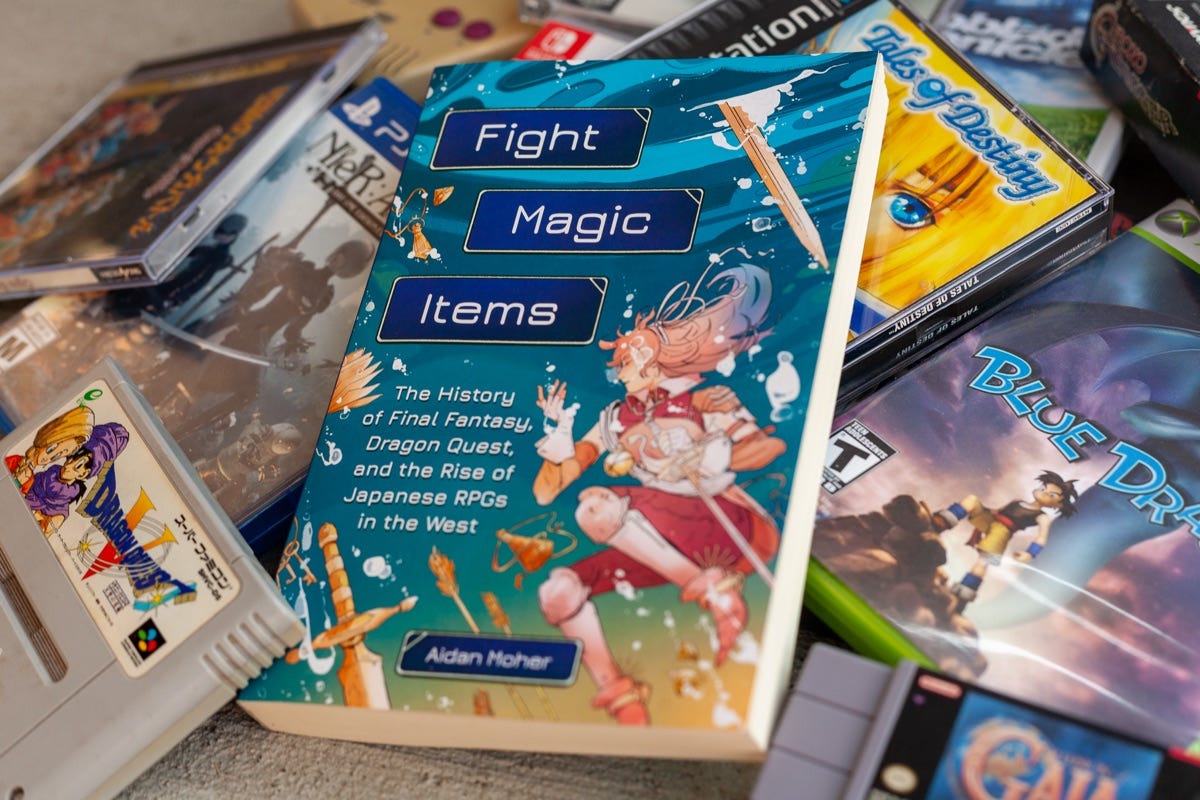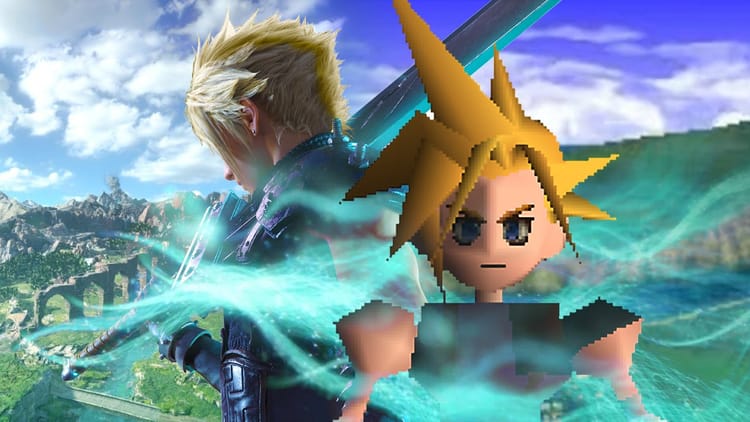Fight, Magic, Items is a year old!
Welcome to Video Game History Week! In honour of the first anniversary of my book Fight, Magic, Items: The History of Final Fantasy, Dragon Quest, and the Rise of Japanese RPGs in the West, Astrolabe is celebrating video game history with a plethora of stories, features, lists, and interviews about video games, the people who make them, and the people who write about them.
Fight, Magic, Items is on sale! Use the code “LEVELUP” at checkout to get 20% off a physical copy through the Running Press website!

Party up!
A year ago today, on October 4th, 2022, my debut book hit store shelves. Fight, Magic, Items is a history of Final Fantasy, Dragon Quest, and the rise of Japanese RPGs in the west, told through the personal perspective of a young Canadian fan (me!) who grew up during their (first) golden age in the 90s!
You can find out more on the official Fight, Magic, Items website, which has all sorts of fun things like excerpts, links to coverage, hi-res cover art, and more, more, more!
As a kid who grew up with an equal love for books and video games, my career as a writer dovetailed into this wonderful opportunity to bring those two things together into one story. When I first started writing seriously about video games, I recognized that, to me, the most interesting way to examine them is to find the stories about the people who make and play them. Fight, Magic, Items is my love letter to the passion and creative drive of the creators—pioneers like Dragon Quest’s Yuji Horii, Final Fantasy’s Hironobu Sakaguchi, and Phantasy Star’s Rieko Kodama—all the way to the second generation of game designers who grew up with Chrono Trigger and Earthbound inspiring them to create something new.
The opportunity to write Fight, Magic, Items was a dream come true, and I’m immensely grateful to my agent Eric Smith for helping the idea come to life, Britny Perilli and the rest of the Running Press team, for making that idea shine as bright as possible, and the overwhelmingly supportive readers I’ve met along the way. There’s a whole lot of me in Fight, Magic, Items, and to see other readers and fans connect with the individual experiences I had as a kid has helped me realize even further how video games bring us all closer and make the world a better place.
It’s fun and all to celebrate the success, and Fight, Magic, Items has absolutely been a success, as you’ll see later, but, first, what’d I learn over the last year, and what do I wish I knew before I’d started?
Well.
Reviews, man
For the most part, reviews of Fight, Magic, Items have been strong from readers and critic—and it’s carrying a healthy 4+ average rating on Amazon and Goodreads—and I was relieved that the audience connected with my goal of writing a book that feels like sitting across the table with your bestie, sharing a drink and talking about your favourite games.
Matthew Rodriguez at them called it, “a well researched and well reported dive into the popular emergence of the JRPG genre and would make a welcome addition to any gamer’s bookshelf.”
“The time and attention Moher pays to the contributions of entire development teams, especially writers, artists, and composers, also makes the story feel complete,” said RPGFan’s Hilary Andreff. “It reads like a very well-informed and well-spoken friend discussing the evolution and future directions of a shared hobby.”
Nerds of a Feather called it a “must buy.”
That’s the kinda stuff you want to read as a debut author. The kind of stuff that, hopefully, sets you on the path to success and future books. But, it’s not always that easy.
When you’re setting out to write a book like Fight, Magic, Items, early on you have to define your audience, and for this book my editor and I decided that a) it’d lean more toward the pop history, and b) its readers would like video games and be familiar with Final Fantasy, even if they weren’t active fans. I think the book succeeds at hitting that goal—it focuses on popular mainstream titles/series that intersect with Final Fantasy and Dragon Quest through elements like heavy inspiration, shared audiences/creators, or subversive and/or evolutionary elements, but at the expense of really exploring off the beaten path and getting into the weeds. I’m happy with the way I was able to balance the researched, historical stories about Japanese RPGs and the people who make them, and my own memoir-style recollections of being a fan during the genre’s coming-of-age.
With that said, I noticed a pattern in the handful of critical reviews that was, I believe, unavoidable. While reviews have been predominantly positive, there’s been a subset of more academically-inclined readers who came into the book expecting and/or hoping for a more rigorous historic record outside the purview of what I generally write (history girded by personal experience and nostalgia) and Running Press publishes. The most retweeted comment about the book on Twitter (by far), was a short critical thread from Felipe Pepe (himself a writer of excellent comprehensive games history books), who said:
I'm reading 'Fight, Magic, Items', but I'm having issue with how personal it is... it mixes historical facts & devs quotes with the writer's VERY rose-tinted childhood memories, I'm unsure what's the intended goal of the book, besides giving a very personal overlook on the genre.
It’s phrased as criticism, but accurately identifies the book’s goal to be a personal overview of the genre through the lens of a fan’s experience growing up in the 90s. In fact, the book was originally pitched as “Fight, Magic, Items: A Personal History of Japanese RPGs.”
Conversely, Mathias Micheel wrote a long review—one of the longest out there—about how he wanted less of the recorded history and more of the personal memoir:
I wish Moher would have written a much more personal book on his experience with the genre instead of trying to write a semi-journalistic, semi-historic book on it. I wish Moher would have written a much more personal book on his experience with the genre instead of trying to write a semi-journalistic, semi-historic book on it. The best chapter of the book probably is the prologue, in which Moher describes his love for the genre and how JRPGs accompanied him throughout life (this prologue is littered with unnecessary footnotes, by the way). These are the stories worth telling. Not how Final Fantasy got its name.
What’s a writer to do? Lean into my personal experiences at the expense of academic rigour? Or pull back and focus on being a primary source at the expense of the book’s personal narratives? Both are fine approaches to writing a history, but neither would be the book I wanted to write—or my editor wanted to buy—and each would further dissatisfy the other and the majority of my readers who enjoyed the version of the story I ultimately told.
The ultimate lesson here, and one that I hope is freeing for other writers, is that you cannot possibly satisfy everyone. Most readers who take the time to review the book get what I was going for—a highly researched and sourced history of a genre centred specifically on my personal experience in the 90s as a proxy for the reader. It’s a journey with many different main characters. I enjoyed watching the narrative ebb-and-flow, and decided which experience to focus heavily on for any given moment: Hironobu Sakaguchi’s childhood dreaming of being a rock star, my initial disdain for the genre, and the night my babysitter helped me fall in love with Final Fantasy VI, the community of fans behind Operation Rainfall, and the modern creators inspired by classic Final Fantasy to make new RPGs like Sea of Stars. It’s impossible to tell every story in a single book—Fight, Magic, Items was 40k words longer than it was supposed to be. So, instead, I wanted to tell the most interesting story I could in the space given: a story about people. The people who make Japanese RPGs, and the people who love them.
Marketing, man
I spent an unhealthy amount of time daydreaming about my book’s success: podcast invites from all my favourite, super popular gaming podcasts, holiday gift guides (many thanks to Tomorrow and Tomorrow and Tomorrow for being the defacto and singular video game-related book on every 2022 gift guide), book crates, editor’s choice lists, features on big gaming sites, being a primary voice discussing the year’s biggest Japanese RPGs and Final Fantasy releases. You know, breaking through as THE guy for western perspectives on Japanese RPGs and their history.
None of that happened.
It was fun to daydream, but the reality for most books is a slow burn.
It’s well documented that most writers are more or less on their own for marketing and promoting their books. I was fortunate to have a hard-working marketing and PR team at Running Press who believed in Fight, Magic, Items, but even with that resource, it’s been hard to get consistent coverage for the book—especially from larger, mainstream gaming publications.
So, I pounded the pavement, booking some great interviews on smaller podcasts, pitching like crazy and landing some nice features, and pushing the book as much as possible online. Only, I have no real concrete evidence that any of that made a difference. Social media doesn’t sell books. Breaking out of your bubble is tough. So, halfway through the year, I decided to stop worrying so much and chase opportunities that were fun, and might help sell a couple copies of my book as collateral damage.
Would I like to see more ratings and reviews of Fight, Magic, Items on the big book sites? Heck yeah. Would I like to see it covered and cited on major gaming sites? You know it. Has it earned out? Nope. Will it? I dunno! Has it sold above my threshold for personal embarrassment? Yes, quite handedly. But, if there’s one thing I wish I knew a year ago, it’s that most of those things are outside the author’s control.
All you can really do is write the best book you can.
And then write the next one.
Highlights, man
And, well, Fight, Magic, Items had a pretty darn good year, even if I didn’t get to go on The Late Show to talk about why Chrono Trigger rules. Here’s a run down of some of the amazing coverage:
- ComicBook.com’s Jamie Lovett said Fight, Magic, Items “belongs on any bookshelf dedicated to the history of video games.”
- Legendary JRPG localizer Alexander O. Smith called it “an essential history and a fun read!”
- Games writer and author Mary Kenney said Fight, Magic, Items is an “informative, personal, and fascinating, this book earns its place among deep dives into video-game history.”
- Fight, Magic, Items was included on CBC’s “40 Canadian books we can't wait to read in October” list.
- RPGFan called Fight, Magic, Items “a trove of extensive information” in their generous, review. “The time and attention Moher pays to the contributions of entire development teams, especially writers, artists, and composers, also makes the story feel complete. But again, because of the personal touches, it reads like a very well-informed and well-spoken friend discussing the evolution and future directions of a shared hobby.”
- Fight, Magic, Items excerpts appeared on Engadget and io9.
- Nerdist revealed the beautiful Sara Alfageeh cover for Fight, Magic, Items.
- I did a long interview with ComicBook.com’s Jamie Lovett. “Japanese RPGs weren't always my favorite thing,” I said. “When I was a kid, I talk in the book about how I just wanted to play Ninja Turtles and Mario and platformers and more fast-paced action-based games. Japanese RPGs seemed a little weird and boring at first.”
- My agent Eric Smith did a deep dive into my book proposal for Fight, Magic, Items.
- “One of the great things about writing about all these older games now is that context gives us so many interesting new lenses to examine their successes and failures,” I told at . “Long gone are the times of small capsule reviews in the back of gaming magazines — they've been replaced by so much genuinely great, deep, longform analysis. It's great.”
- Fight, Magic, Items was cited in Kotaku’s review of Sea of Stars. (It’s a little silly, but this was the moment it felt like a real book to me. Author brains are weird and we need constant reminders that the effort we put into our books is worthwhile.)
- I appeared on a lot of podcasts, including, but not limited to, Retrograde Amnesia, RPGFan, Everybody’s Talking At Once, Memory Card, and Still Loading.
- Fight, Magic, Items was featured on Gizmodo’s “15 Excellent Nerdy Nonfiction Books” list.
- And, it was featured on Quill & Quire, Capital Daily, them, and Smart Bitches Trashy Books.
Add-ons, man
One of the biggest challenges of writing this book was picking and choosing what stories made it into the final draft. I had to make a few cuts that I knew were great stories, but didn’t fit neatly into the book’s structure. (Like I said earlier, as published, it was already 40k words longer than I’d pitched. Much to my editor’s chagrin. Hi, Brit!) Fortunately, I was able to bring a few of these back to life as features on various websites:
“How the greatest Japanese RPGs of the ‘90s came to the West” for Washington Post is a deepdive interview with Alexander O. Smith (Vagrant Story) and Richard Honeywood (Xenogears, Dragon Quest VIII) about the transformative work they and their colleagues did in the late 90s to transform how we think about game localization.
Early on, Honeywood watched a dub of the game’s opening anime sequence, which had been overseen by Baskett before his departure. In it, a generational starship is attacked and destroyed by an otherworldly being, leading to the awakening of a mysterious woman on an alien planet. “Xenogears” was one of the first JRPGs to feature voice acting, so Honeywood knew it was essential to get it right for Western audiences. He noticed immediately that the voice flaps (the character’s voice acting lining up with their mouth moving) didn’t match, but, according to Honeywood, “that was the least of the problems.”
“Lost in Translation” for Unwinnable is a look at how Sega’s much-maligned Saturn is one of the all-time great Japanese RPG consoles… just not in the west.
When you think of the Japanese RPG golden age, it recalls the 16-bit era, led by Nintendo’s vast stable of classics like Earthbound and Chrono Trigger, followed by the PlayStation’s dominance of the 32-bit era when Final Fantasy VII set the genre on a meteoric course for worldwide superstardom. It was a transformational time for Japanese roleplaying games, and created millions of lifelong fans in the process.
We all know how Sega played proud second fiddle during the Japanese RPG arms race of the 16-bit era, but what if I told you Sega, not Nintendo, was home to the second-best library of JRPGs during the 32-bit era, too?
“But, Aidan, the Saturn was a huge flop, has barely any JRPGs, and the ones that do exist cost, like, a million dollars.”
Yes.
Correct.
But!
Fin
This isn’t even close to the end of the road for Fight, Magic, Items. It’s only really the beginning of the story. It’s left its home village, gained a few levels, bought new armour, and gathered some friends.
It’s always challenging to write a history that reaches the present point in time. By the time Fight, Magic, Items came out a year ago, I was barely able to squeeze in mentions of games like Xenoblade Chronicles 3 and Final Fantasy XVI. You can be sure I’d have loved to have discussed what the Persona 3 remake and Baten Kaitos remasters singled about the future of those series, and the increasing popularity of Falcom’s Trails series makes it feel like a missing link in the book’s latter half. But, that was inevitable—because there’s always something new on the horizon.
What I’m really proud of, and what I think will give the book legs long into the future, are the foundational stories I’ve told about the genre’s origins, and the people who make, play, and love Japanese RPGs. Those? Those’re timeless.
Support
There are lots of ways to support Astrolabe and my other work. Check ‘em out!
Keep In Touch
Enjoy Astrolabe? Want more SFF and retro gaming goodies? You can find me on Twitter and my website.
Credits
Astrolabe banner photo by Shot by Cerqueira on Unsplash




Member discussion